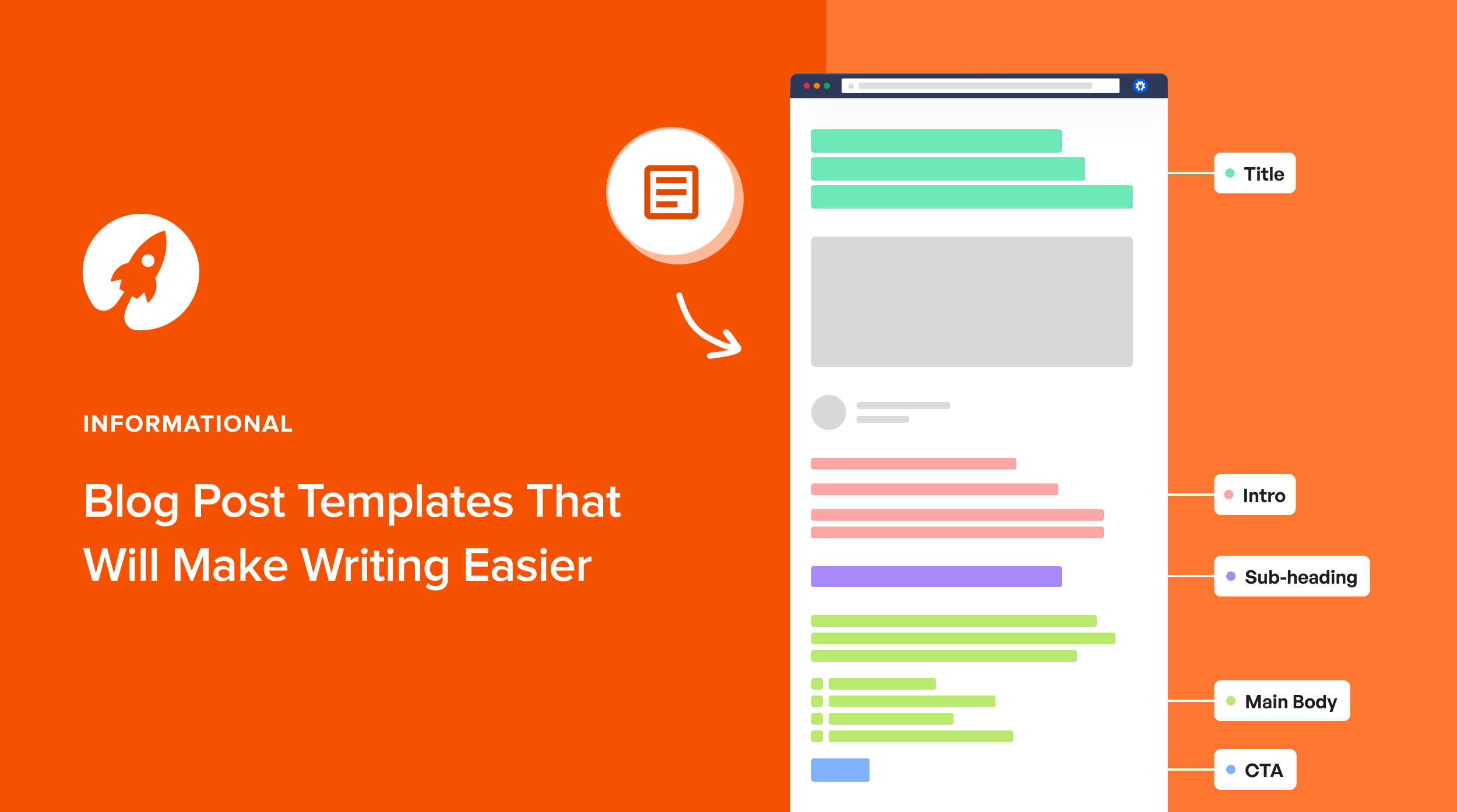Ever found yourself staring at a blank screen, trying to figure out how to structure your next blog post? Or looking for blog post templates to reduce your manual workload?
Yeah, I’ve been there.
And honestly, one of the biggest challenges of blogging is not just coming up with content ideas but knowing how to present them in a way that keeps readers hooked and eager for more.
That’s where blog post templates come in handy.
Think of them as cheat sheets that make writing easier, more efficient, and way more enjoyable. With the right templates, you can organize your thoughts, save time, and deliver content that feels polished, engaging, and tailored to your audience.
In this post, I’m sharing 8 free blog post templates you can start using today to make your writing process smoother and more effective. Trust me, once you try them, you’ll wonder how you ever managed without them.
Let’s start with a definition.
What Is a Blog Post Template?
Blog post templates are a predefined framework or outline that guides the structure, writing, and optimization of your content for SEO.
Think of it as a blueprint: it provides a consistent way to organize headlines, subheadings, introductions, body sections, and calls-to-action (CTAs), ensuring that every post adheres to best practices.
Instead of starting from a blank page every time, a template helps streamline your workflow.
For example, a strong blog post template usually includes:
- An attention-grabbing introduction
- Well-organized, keyword-rich subheadings
- Bullet points or visuals for clarity
- A conclusion that ties everything together with a clear next step
From an SEO perspective, templates are invaluable because they ensure you don’t overlook critical on-page elements like meta descriptions, internal links, and keyword placement.
I usually pair them with SEO tools like SEOBoost to go beyond structure and actually align every blog with search intent, readability, and ranking factors.
8 Blog Post Templates That Will Make Writing Easier
Let’s move on to my favorite part: the 8 blog post templates I’ve created to make writing (and content optimization) a whole lot easier for you and me.
1. The Classic List Post
Purpose: Provide valuable information in a simple, step-by-step manner.
Best For: Tips, resources, tools, strategies, or curated lists.
Ah, the classic list post.
It’s the go-to format when you want to present a collection of tips, tools, resources, or strategies in an easily digestible format. List posts are popular because they’re scannable, practical, and super effective for SEO.
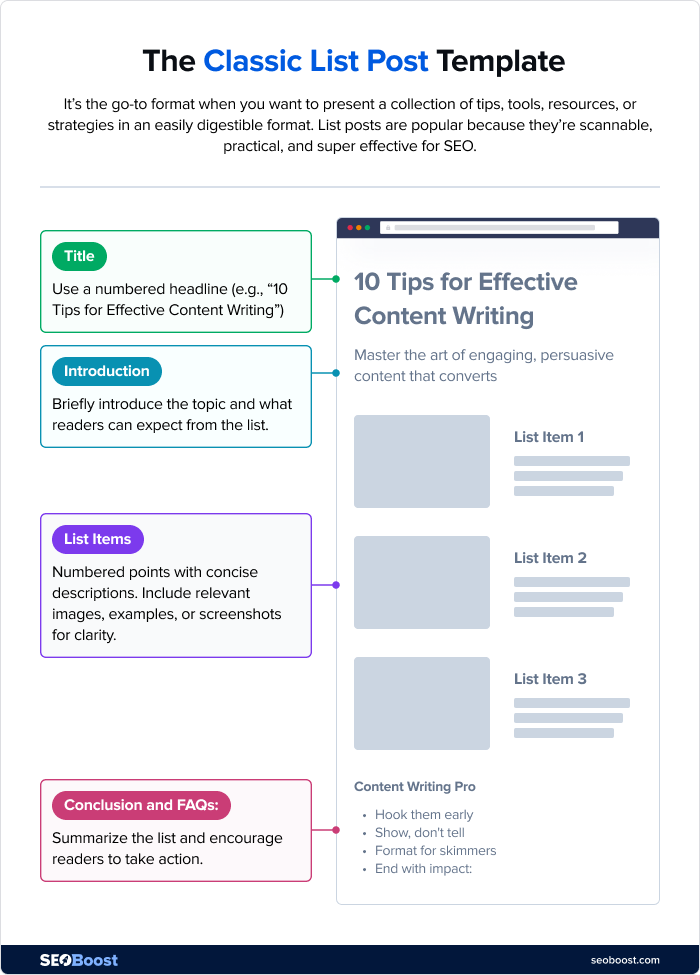
Here’s the structure for this post type:
- Title: Use a numbered headline (e.g., “8 Best Topic Cluster Examples to Plan Your Content”).
- Introduction: Briefly introduce the topic and what readers can expect from the list.
- List Items: Numbered points with concise meta descriptions. Include relevant images, examples, or screenshots for clarity.
- Conclusion and FAQs: Summarize the list and encourage readers to take action.
I’d advise combining your list post with SEOBoost’s Content Briefs to structure each point around relevant keywords and ensure your content is aligned with search intent.
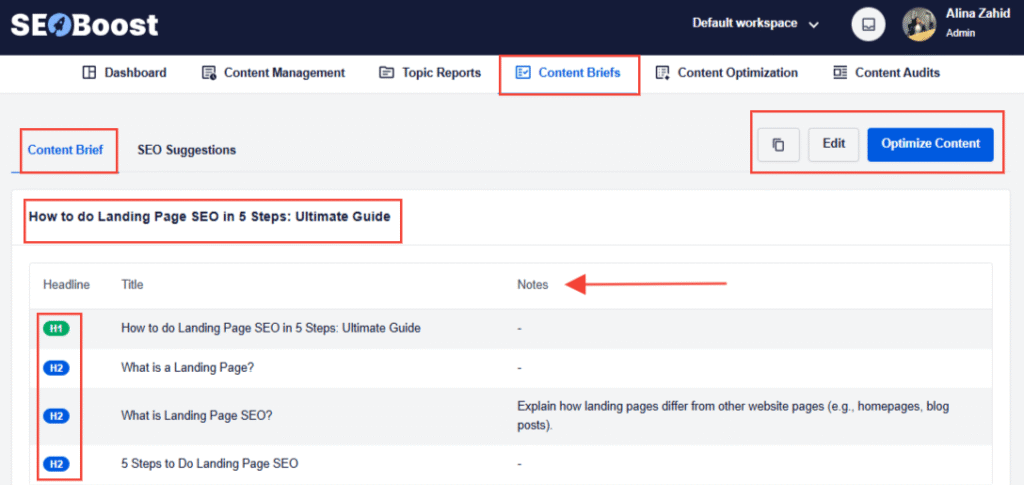
You can also add subheadings and notes for each item on the list.
This would help you (or your team) understand each subheading better and create a clear blog structure.
2. The How-To Guide
Purpose: Provide detailed, step-by-step instructions for completing a task or solving a problem.
Best For: Tutorials, processes, strategies, guides, or walkthroughs.
If your goal is to help readers achieve something specific, nothing beats a well-crafted How-To Guide. It’s all about providing clear, actionable steps that guide your audience from Point A to Point B.
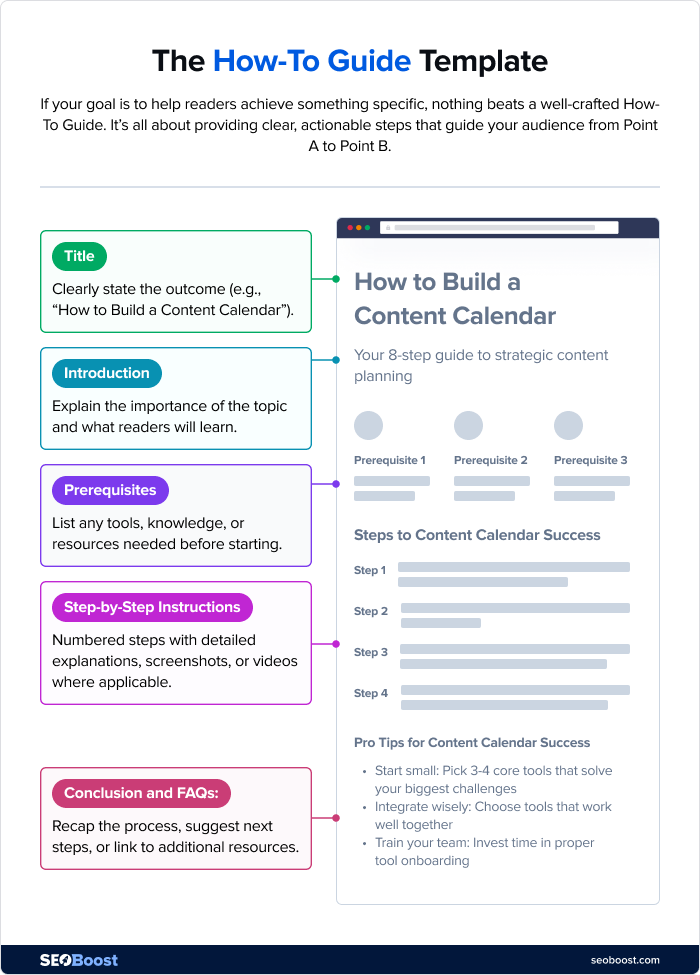
Here’s the structure for this:
- Title: Clearly state the outcome (e.g., “How to Create Content Marketing Workflows for Your Strategy”).
- Introduction: Explain the importance of the topic and what readers will learn.
- Prerequisites: List any tools, knowledge, or resources needed before starting.
- Step-by-Step Instructions: Numbered steps with detailed explanations, screenshots, or videos where applicable.
- Conclusion and FAQs: Recap the process, suggest next steps, or link to additional resources.
Before publishing, use SEOBoost’s Content Optimization feature to make sure your guide meets all readability and SEO requirements.
3. The Case Study
Purpose: Share real-world experiences to illustrate the effectiveness of a strategy, tool, or approach.
Best For: Showcasing success stories, building credibility, and providing social proof.
Case studies are perfect for showcasing real-life success stories. They demonstrate the effectiveness of a particular strategy or tool, backed by data and tangible results.
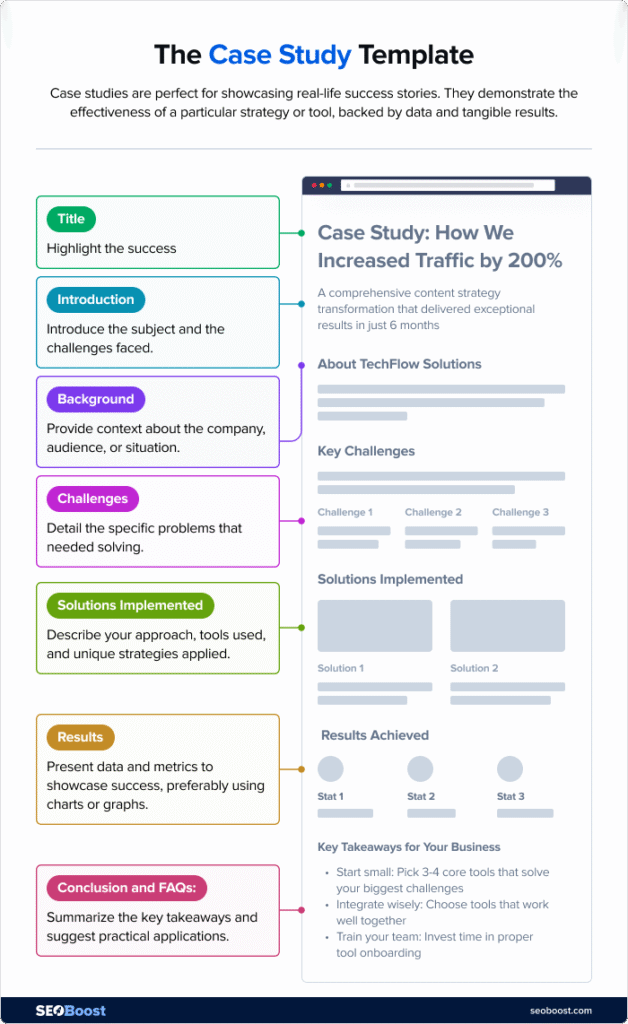
To structure them properly, use this template:
- Title: Highlight the success (e.g., “How a Baking Blog Grew Organic Traffic by 295% in 6 Months”).
- Introduction: Introduce the subject and the challenges faced.
- Background: Provide context about the company, audience, or situation.
- Challenges: Detail the specific problems that need to be solved.
- Solutions Implemented: Describe your approach, SEO tools used, and unique strategies applied.
- Results: Present data and metrics to showcase success, preferably using charts or graphs.
- Conclusion and FAQs: Summarize the key takeaways and suggest practical applications.
Case studies are a great way to exhibit your product’s use case. Make sure you cover all the right data points and optimize your content for better visibility.
4. The Tutorial
Purpose: Provide a comprehensive, instructional guide to mastering a specific topic.
Best For: In-depth guides, educational content, and technical tutorials.
This template is for those in-depth, walkthrough-style posts where you break down complex topics into easily understandable chunks.
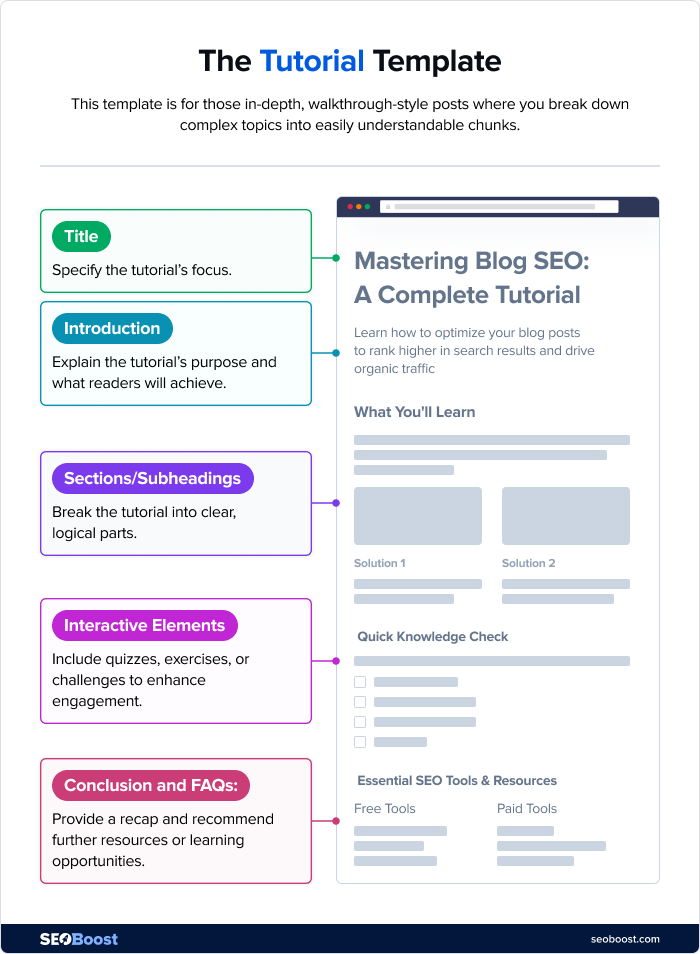
To structure your tutorial blog post templates, do this:
- Title: Specify the tutorial’s focus (e.g., “SEO for Blog Posts: How to Use SEOBoost to Optimize Articles”).
- Introduction: Explain the tutorial’s purpose and what readers will achieve.
- Sections/Subheadings: Break the tutorial into clear, logical parts.
- Interactive Elements: Include quizzes, exercises, or challenges to enhance engagement.
- Conclusion and FAQs: Provide a recap and recommend further resources or learning opportunities.
You can also keep track of your tutorial drafts with SEOBoost’s Content Management feature to streamline the entire process.
Using this feature, you can assign due dates, writers, reviewers, and plan your entire editorial calendar. This can also help align your product releases with the associated tutorials.
5. The Comparison Post (Battle of the Best)
Purpose: Compare multiple products, services, or strategies to guide readers toward the best choice.
Best For: Product comparisons, software reviews, service evaluations, or strategy breakdowns.
If you’re like me, you’ve spent way too much time Googling “X vs Y” to figure out which tool or strategy is better. That’s why comparison posts are pure gold for your audience. They help readers make informed decisions without wasting time.
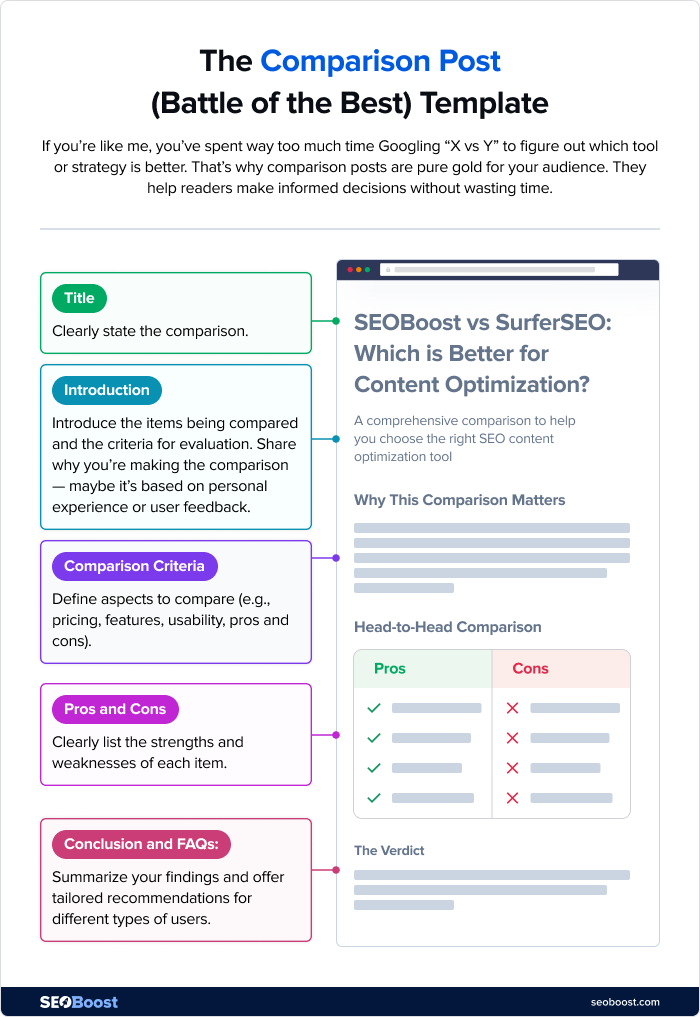
To structure your comparison posts, do this:
- Title: Clearly state the comparison (e.g., “SEOBoost vs SurferSEO: Which Is Better for Content Optimization?”).
- Introduction: Introduce the items being compared and the criteria for evaluation. Share why you’re making the comparison, based on personal experience or user feedback.
- Comparison Criteria: Define aspects to compare (e.g., pricing, features, usability).
- Pros and Cons: Clearly list the strengths and weaknesses of each item.
- Conclusion and FAQs: Summarize your findings and offer tailored recommendations for different types of users.
Using SEOBoost’s Topic Reports before starting a comparison post helps me identify all the comparison-related keywords to cover.
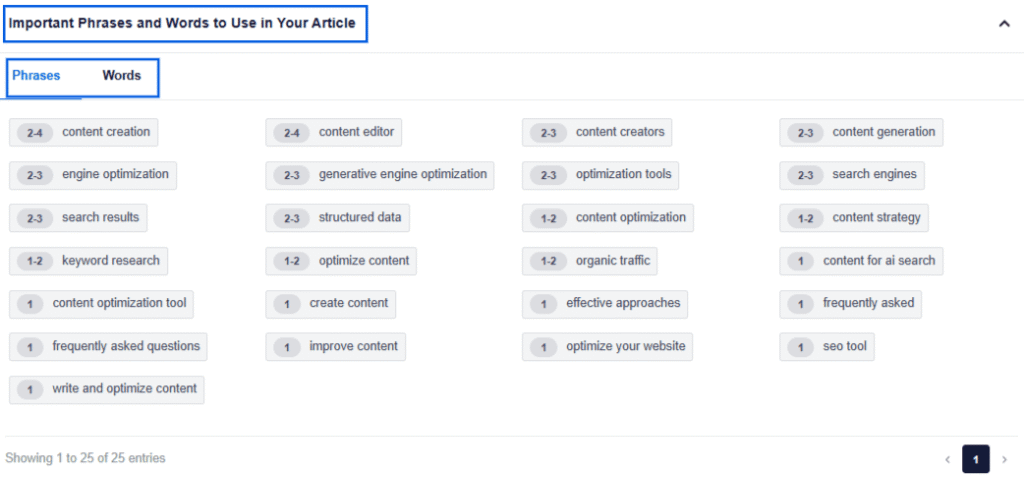
It’s a simple but powerful way to make sure my post ranks high.
Using this, you can easily identify all the important phrases and words that you can use in your blog posts.
6. The Ultimate Guide (The All-In-One Resource)
Purpose: Provide a comprehensive, all-in-one resource on a broad topic.
Best For: Authoritative content, evergreen resources, and educational guides.
When I really want to make a piece of content stand out as a go-to resource, I go for an ultimate guide. It’s a monster of a post, but it’s worth it because it attracts backlinks, generates organic traffic, and establishes authority.
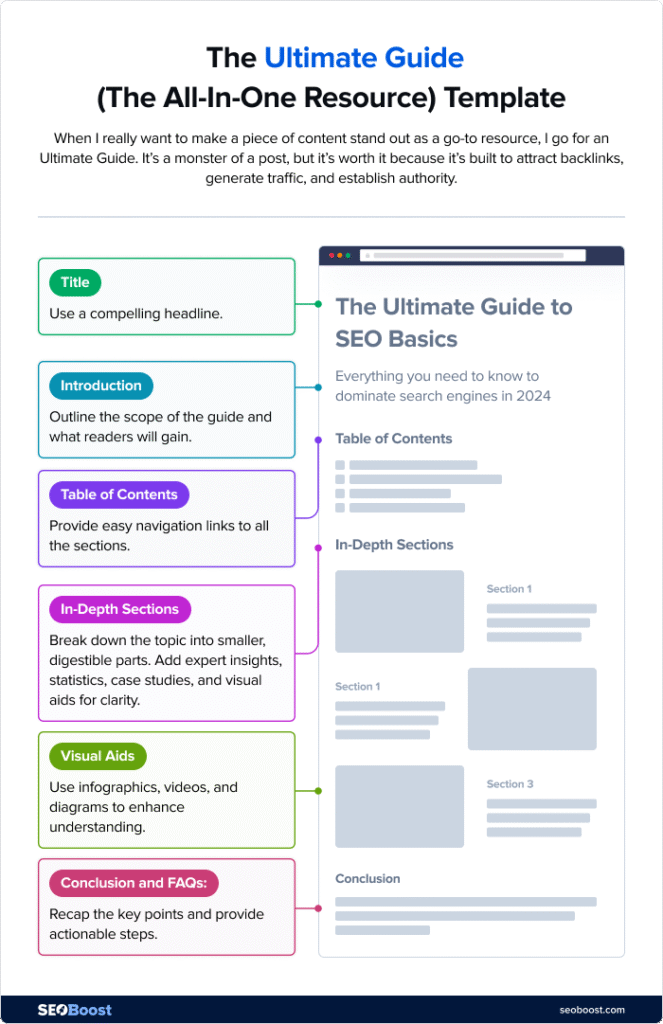
Here’s how to structure the blog post templates for ultimate guides:
- Title: Use a compelling headline (e.g., “The Ultimate Guide to SEO Basics”).
- Introduction: Outline the scope of the guide and what readers will gain.
- Table of Contents: Provide easy navigation links to all the sections.
- In-Depth Sections: Break down the topic into smaller, digestible parts. Add expert insights, statistics, case studies, and visual aids for clarity.
- Visual Aids: Use infographics, videos, and diagrams to enhance understanding.
- Conclusion and FAQs: Recap the key points and provide actionable steps.
Combining SEOBoost’s Topic Reports and Content Optimization features helps ensure the guide covers every relevant keyword and provides real value to my readers.
7. The Resource Post (Sharing The Best Of The Best)
Purpose: Share a curated list of resources that provide value to your audience.
Best For: Tool lists, helpful guides, recommended readings, or industry resources.
If you’ve ever bookmarked a “Top 10 Tools for [X]” blog post, you know how valuable resource posts can be. They save people the trouble of scouring the internet by presenting them with all the valuable resources they need in one place.

You can structure them this way:
Structure:
- Title: Present the value upfront (e.g., “5 Best Keyword Research Tools”).
- Introduction: Explain why you’ve curated the list and what readers will gain from it.
- Resource List: Provide a well-organized list of resources, each with a brief description and link.
- How to Use: Include practical tips on how readers can effectively use each resource.
- Conclusion and FAQs: Recap the list and encourage readers to explore the recommended resources.
8. The Expert Roundup Post
Purpose: Gather insights from industry experts on a specific topic to provide diverse perspectives.
Best For: Opinion pieces, trend forecasts, expert advice, or niche-specific discussions.
Want to pack tons of value into one post without doing all the heavy lifting yourself? Enter the expert roundup post. I love this template because it combines multiple expert opinions into one super-informative piece that your audience will love.
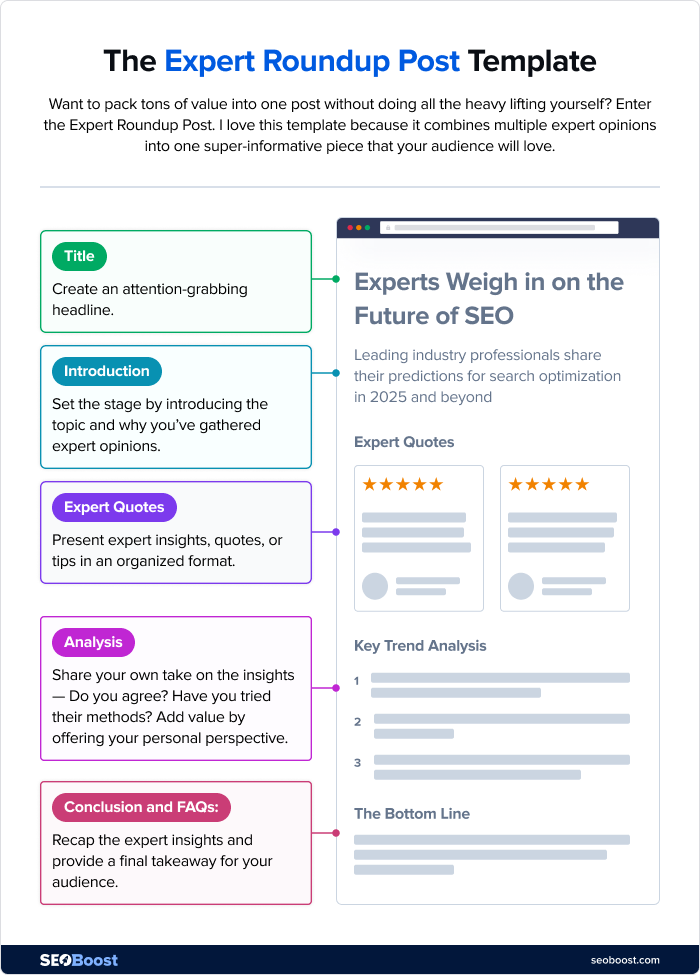
Here’s how to structure your expert roundup posts:
- Title: Create an attention-grabbing headline (e.g., “Best Proven Content Optimization Tips by 9 SEO Experts”).
- Introduction: Set the stage by introducing the topic and why you’ve gathered expert opinions.
- Expert Quotes: Present expert insights, quotes, or tips in an organized format.
- Analysis: Share your own take on the insights — Do you agree? Have you tried their methods? Add value by offering your personal perspective.
- Conclusion and FAQs: Recap the expert insights and provide a final takeaway for your audience.
After gathering insights, run the post through SEOBoost’s Content Optimization feature to ensure the final product is search-friendly and engaging.
Final Thoughts
Blog post templates are game-changers.
They help you break down your ideas into structured, engaging, and easily consumable content. Plus, when you pair these templates with tools like SEOBoost, your content creation process becomes incredibly streamlined and effective.
It’s not about reinventing the wheel. It’s about making the wheel work better for you.
So go ahead, try these templates and see how much easier your content creation process becomes.
Blog Post Templates FAQs
Blog post templates are a structured framework that helps you organize your thoughts and create content faster and more effectively. By using them, you can make your content creation process more efficient and optimized.
Start with a clear idea, outline your structure, research thoroughly, write engagingly, and optimize with tools like SEOBoost’s Content Optimization feature. This will help ensure that your blog post templates are structured and aligned with the search intent.
It depends on your purpose. For actionable advice, use how-to guides. For quick information, try list posts. For in-depth resources, go with the ultimate guides.


